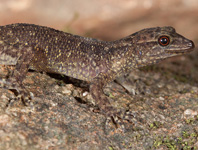Abstract
A distinct group of Abantiades Herrich-Schäffer species is here confirmed as a valid clade that we refer to as the “dark obscura clade” supported by morphological and mtDNA evidence. The clade is the sister group of A. obscura Simonsen of north-western Australia and comprises four new species: Abantiades centralia sp. nov., A. kayi sp. nov., A. zonatriticum sp. nov., and A. hutchinsoni sp. nov. These species together with A. obscura, are reciprocally allopatric and have a combined distribution spanning much of the western half of Australia and this distribution is consistent with their each differentiating locally from a widespread ancestor. The four new species raise the diversity of Abantiades to 42 species. [Zoobank urn:lsid:zoobank.org:pub:C05458D1-0D34-4432-8EC4-D031ED6B7BEF]
References
Beaver, E.P., Moore, M.D., Velasco-Castrillón, A. & Stevens, M.I. (2020) Three new ghost moths of the genus Oxycanus Walker, 1856 from Australia (Lepidoptera: Hepialidae). Zootaxa, 4732 (3), 351−374.
https://doi.org/10.11646/zootaxa.4732.3.1
Dorey, J.B., Schwarz, M.P. & Stevens, M.I. (2019) Review of the bee genus Homalictus Cockerell (Hymenoptera: Halictidae) from Fiji with description of nine new species. Zootaxa, 4674 (1), 1–46. Dugdale, J.S. (1994) Hepialidae (Insecta: Lepidoptera). Fauna of New Zealand, Canterbury, New Zealand, 30, 1–164.
Dumbleton L.J. (1966) Genitalia, classification, and zoogeography of New Zealand Hepialidae (Lepidoptera). N.Z. journal of science, 9 (4), 920–981.
Felsenstein, J. (1985) Confidence limits on phylogenies: An approach using the bootstrap. Evolution, 39, 783–791.
https://doi.org/10.1111/j.1558-5646.1985.tb00420.x
Folmer, O., Black, M., Hoeh, W., Lutz, R. & Vrijenhoek, R. (1994) DNA primers for amplification of mitochondrial cytochrome c oxidase subunit I from diverse metazoan invertebrates. Molecular Marine Biology and Biotechnology, 3, 294–299.
Grehan, J.R. & Mielke, C.G.C. (2018) Evolutionary biogeography and tectonic history of the ghost moth families Hepialidae, Mnesarchaeidae, and Palaeosetidae in the Southwest Pacific (Lepidoptera: Exoporia). Zootaxa, 4415 (2), 243–275.
https://doi.org/10.11646/zootaxa.4415.2.2
Grund, R., Stolarski, A. & Stevens, M.I. (2019) Rediscovery of Synemon selene (Lepidoptera: Castniidae) in the mid-north of South Australia. Transactions of the Royal Society of South Australia, 143, 86–91.
https://doi.org/10.1080/03721426.2018.1532270
Hausmann, A., Haszprunar, G. & Hebert, P.D.N. (2011) DNA Barcoding the Geometrid Fauna of Bavaria Lepidoptera): Successes, Surprises, and Questions. PLoS ONE, 6 (2), e17134.
https://doi.org/10.1371/journal.pone.0017134
Heads, M. (2014) Biogeography of Australasia. A Molecular Analysis. Cambridge University Press, Cambridge, 493 pp.
Herrich-Schäffer, G.A.W. (1850–[1858]) Sammlung neuer oder wenig bekannter aussereuropäischer Schmetterlinge. G. J. Manz, Regensburg 84 pp., 120 pls.
Javidkar, M., Cooper, S., King, R., Humphreys, W., Bertozzi, T., Stevens, M.I. & Austin, A. (2016) Molecular systematics and biodiversity of oniscidean isopods in the groundwater calcretes of Central Western Australia. Molecular Biology and Evolution, 104, 83–98.
https://doi.org/10.1016/j.ympev.2016.07.026
Kumar, S., Stecher, G., Li, M., Knyaz, C. & Tamura, K. (2018) MEGA X: Molecular Evolutionary Genetics Analysis across computing platforms. Molecular Biology and Evolution, 35, 1547–1549.
https://doi.org/10.1093/molbev/msy096
Posada, D. & Crandall, K.A. (1998) Modeltest: testing the model of DNA substitution. Bioinformatics, 14, 817–818.
https://doi.org/10.1093/bioinformatics/14.9.817
Simonsen, T.J. (2018) Splendid Ghost Moths and Their Allies. Monographs on Australian Lepidoptera, 12, i−xi + 1−300.
https://doi.org/10.1071/9781486307487
Simonsen, T.J., Moore, M.D., Dupont, S.T. & Stevens, M.I. (2019) Testing DNA barcodes against morphology for the ‘tripectinate Abantiades’ (Lepidoptera: Hepialidae) reveals a complex relationship between COI sequence data and morphology. Austral Entomology, 58, 792–799.
https://doi.org/10.1111/aen.12395
Stephens, J.F. ([1828]−1829) Illustrations of British Entomology; or, A Synopsis of Indigenous Insects: Containing their generic and specific distinctions; with an account of their metamorphoses, times of appearance, localities, food, and economy as far as practicable. Haustellata. II. Baldwin and Cradock, London, 203 pp. [pp. 1−80, pls. 13−18 (1828), pp. 81−203, pls.19−24 (1829)]
Swofford, D. (2002) Paup*. Version 4.0. Phylogenetic Analysis Using Parsimony (and Other Methods). Sinauer Associates, Inc., Sunderland, Massachusetts.
Tamura, K. & Nei, M. (1993) Estimation of the number of nucleotide substitutions in the control region of mitochondrial DNA in humans and chimpanzees. Molecular Biology and Evolution, 10, 512–526.
Tindale N.B. (1932) Revision of the Australian Ghost Moths (Lepidoptera, Homoneura, Family Hepialidae) Part 1. Records of the South Australian Museum, IV (4), 500–505.


